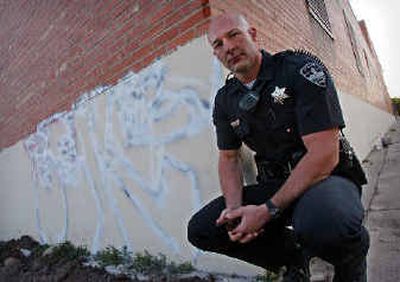Little crimes cost big: Vandalism pricey, frequent

BOISE – A long scratch mars the side of a new car. Barn windows shattered from thrown rocks. Spray paint scars the side of a home, a store’s sign is defaced, a public restroom trashed, a grave marker tipped over.
Vandalism – often considered a minor crime or a juvenile prank – is on the rise in Idaho. And law enforcement officials say the problem is costing residents time and money.
More than $8 million in vandalism-related property loss and damage was reported to police in 2003, according to statistics from the Idaho State Police. That was an increase of 4.3 percent from the previous year.
In one Coeur d’Alene case, the loss is estimated at more than $20,000.
Darrell Dlouhy with the No Moose Left Behind Community Art Project said the fiberglass moose sculptures central to the education fund-raiser have been targeted by vandals.
Twenty-four of the hand-painted sculptures were placed around town, intended to be auctioned off to raise funds for area teachers.
Bids for one of the moose had reached $20,000 when it was chipped away from its base and stolen. Other sculptures were tipped over or broken.
“We had known to expect some vandalism, but this has been pretty frequent,” Dlouhy said. “So much of what we do is volunteer, just time and effort. Now we’re going to end up spending some money installing surveillance cameras.”
Artist Jennifer Riggs is working on repairing her moose in the exhibit. Vandals broke a tiny astronaut off the rump of the fiberglass animal, titled “First Man on the Moose.” She is retitling the piece “Second Man on the Moose.”
“We had a feeling before it ever went up that it could be a target for this sort of thing, but I wasn’t going to let that affect my decision to put it up,” Riggs said. “I was really disappointed, not because of me, but mainly that someone would have the disrespect to do this sort of thing to a project that’s there to help the community.”
The bulk of vandalism’s costs come from damaged cars, according to the Idaho State Police. They accounted for more than $3.3 million reported lost by Idaho businesses and residents in 2003. Damage to structures, although less frequent, can be more problematic because graffiti is often difficult to repair, police said.
In Boise, police have been spending much of their time investigating a spray-painting vandalism spree. The vandalism is showing up on public and private buildings downtown. Most often it is simply a series of letters: BSK or OSC. Authorities say they do not believe the so-called tagging is connected to gang activity.
“We’re seeing a rise with the weather getting warmer, and seeing more and more from the “BSK” or “OSC” group,” said Coy Bruner, the Boise police officer investigating the case. “We’re trying to get them corralled up, but it’s like a needle in a haystack. We’re seeing more than in years past, that’s for sure.”
Repairing most of the damage takes more than a simple paint job, Bruner said. Often spray-paint must be sandblasted off concrete or brick, and the building is left with a discolored area, he said.
“Every week I have new reported cases that I have to follow up on, go photograph and get suspect information. It occupies a lot of my time,” he said. “The victims get frustrated because there’s not a lot of follow-up we can do on our end, and we get frustrated because we’re still looking for that one good lead.”